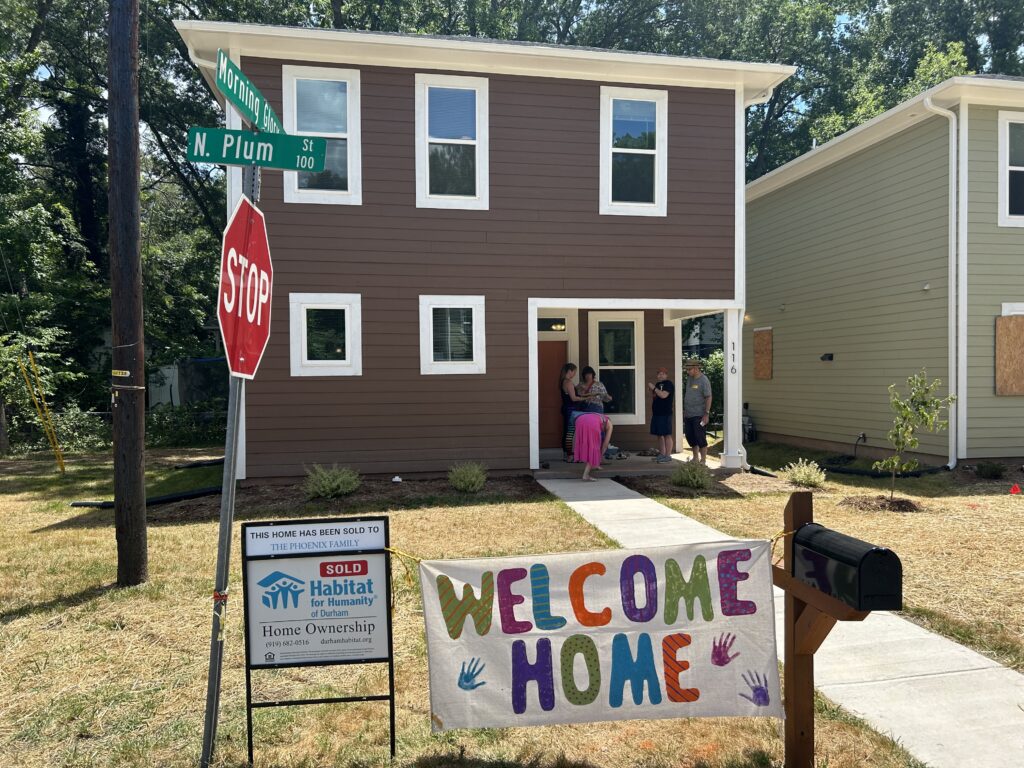Laura Phoenix’s new Habitat for Humanity home in Durham (Photo: Greg Childress)
Surrounded by friends and Habitat Humanity of Durham staff, Laura Phoenix grew emotional Thursday during the dedication of her new home in East Durham.
Just a year ago, the 43-year-old yoga instructor was without permanent housing after a bad break-up. It was the second time as an adult that she’d found herself without a permanent home.
“This situation is not unique to me and some people are in worse shape,” said Phoenix, who has spent the past year living with friends. “We all deserve to live safely, and we shouldn’t have to bust our ass and hand over tremendous amounts of our paychecks to make that happen.”
Laura Phoenix (Photo: Greg Childress)
Phoenix’s home dedication comes just weeks before she is scheduled to close on a new 3-bedroom, 1 1/2-bath home on North Plum Street that has been appraised at $285,000 (Habitat homes are sold at appraised value). The home was built with the help of Habitat volunteers. And as is the case with Habitat homes, Phoenix was required to contribute at least 300 hours of “sweat equity.”
“You know, I liked hammering and I liked putting up walls,” Phoenix said, laughing. “We had a workday that was just my friends putting in the grass and the plants in front of a couple of these houses including this one [the home she bought].”
Thursday’s home dedication also comes during National Homeownership Month. Habitat for Humanity of Durham will recognize two additional local families during home dedications on North Plum Street this weekend.
The lots on which the houses are built was originally zoned for two homes, said Tiana Joyner, CEO at Habitat Durham. It was rezoned to allow seven Habitat homes to be built, Joyner said. “We’re calling these home our skinny Plum lots because they’re a little skinnier [than traditional Habitat lots] and we took advantage of the density to ensure that we could build more homes here.”
Such creative approaches to zoning are becoming increasingly important in the battle to keep pace with the demand for affordable housing in one of the nation’s hottest housing markets, Joyner said. U.S. News and World Report recently ranked Durham the fourth hottest housing market in the nation. Raleigh came in second.
“We call it responsible density,” Joyner said. “As land becomes more scarce in Durham, and just nationally, we have to make best use of the land we have.”
To keep homes affordable, Habitat Durham is looking to build smaller homes and to move into the townhome market for the first time, Joyner said. A 40-unit townhome complex is planned for land the organization purchased near N.C. Central University, Joyner said.
But building smaller homes and increasing density is only a part of the solution to the housing affordability crisis, she said.
Tiana Joyner (Photo: Habitat Durham)
“We have to really get creative because there is an affordability crisis,” Joyner said. “Making homes smaller does not equal making them affordable. There’s a lot of other things that we have to look at like taxes, homeowner’s insurance. All of those things go into factoring affordability. Durham has changed so much, and affordability is looking different for everyone, not just those who need affordable housing.”
In Durham, 18% of homeowners — 13,520 — households have difficulty affording their homes, according to a recent report by the N.C. Housing Coalition. Families that spend more than 30% of their annual or monthly income on housing are considered cost-burdened.
Habitat Durham would prefer that its homes sell for $200,000 or less, Joyner said, but realizes that has become an unlikely scenario due to increased land and material costs.
“Our homes have gone up tremendously,” Joyner said. “We had a home last year that appraised for $310,000. We want our homes to be under $200,000 but this is the new normal, unfortunately.”
Although the North Plum Street homes are near Durham’s highly desired downtown, Joyner said that the trend of higher prices can be found all over the county.
“We’re finding the challenge everywhere,” she said. “We’re working on a project, purchasing off of Duke Street, which is kind of far from downtown, and we’re having a challenge of making the project affordable, so we don’t even know if we’re going to be able to move forward with purchasing it.”
In addition to reducing property taxes and homeowner’s insurance for buyers of affordable housing, Joyner said, elected officials must provide more downpayment assistance and increase subsidies to developers.
“If we can have more assistance with building [affordable housing], we can pass that along to the homeowner,” she said.
Habitat already provides 0% interest loans to homebuyers and forgives some portions of loans.
“The forgivables are getting more and more expensive,” Joyner said. “If we have a homeowner who can only afford $200,000 and the home is $300,000, we have to do a forgivable of $100,000 and sometimes more than that. We can’t afford to do those kinds of forgivables continuously. We do them, but we have to figure something out.”
Homeowners must earn between 50% and 80% of the area median income to qualify for Habitat Durham homes. The median income for Durham is $79,154.
Meanwhile, Phoenix was moved to tears after friend David Huber shared testimony about her recent housing journey.
“This has been a long journey for you, and I know that it’s not been easy, necessarily, when it began,” Huber said. “I’m so excited for you, to get into a place that firmly supports you. You have a place that you can call home.”
The post Maintaining affordability has become a growing challenge in addressing housing crisis appeared first on NC Newsline.

